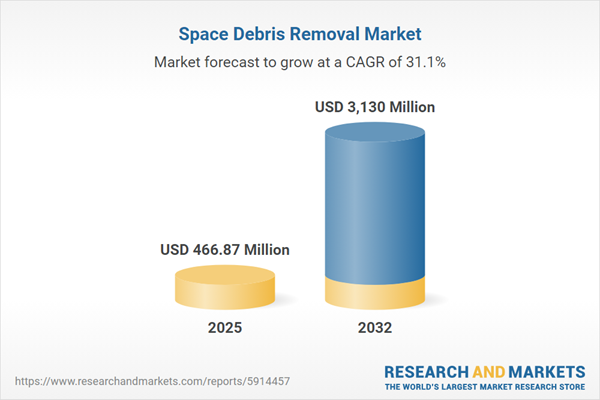Speak directly to the analyst to clarify any post sales queries you may have.
The space debris removal market is entering a defining phase as global stakeholders recognize the mission-critical nature of safeguarding orbital environments. Senior executives seeking to understand competitive advantage, regulatory change, and investment opportunity within space sustainability now require a unified view across technology and policy landscapes.
Market Snapshot: Space Debris Removal Market Growth and Trends
The space debris removal market grew from USD 359.44 million in 2024 to USD 466.87 million in 2025. Projected at a compound annual growth rate (CAGR) of 31.09%, the market is anticipated to reach USD 3.13 billion by 2032. Investors and industry leaders are responding to soaring commercial satellite launches and rising awareness about orbital congestion. Adoption of advanced debris remediation solutions—such as robotic systems and laser ablation—is increasing as government entities and commercial operators prioritize sustainable operational practices for long-term infrastructure protection. This robust expansion is underpinned by accelerating regulatory mandates, technological innovation, and sustained private sector engagement, delineating a strategic inflection point for the primary keyword: the space debris removal market.
Scope & Segmentation
This comprehensive analysis benchmarks critical segments, regional strategies, and emerging technologies shaping competitive positioning. Market segmentation includes:
- Technology Approach: Active removal (harpoons, laser ablation, robotic capture) and passive removal (drag sails, electrodynamic tethers).
- Method: Non space environment-based and space environment-based techniques.
- Orbit Type: Coverage of geostationary, low Earth, and medium Earth orbits.
- Debris Size: Categories include 5-10 cm, above 10 cm, and below 5 cm.
- Debris Type: Collision fragments, defunct satellites, and spent rocket stages.
- End User: Academic and research institutions, commercial satellite operators, government organizations.
- Regional Coverage: Americas (North America, Latin America), Europe, Middle East & Africa (Europe, Middle East, Africa), Asia-Pacific (China, India, Japan, Australia, South Korea, Indonesia, Thailand, Malaysia, Singapore, Taiwan).
- Key Companies: Leading firms include Airbus SE, Astroscale, BAE Systems PLC, Lockheed Martin Corporation, Tethers Unlimited, Inc., and others, reflecting a competitive mix of aerospace incumbents and specialized new entrants.
Key Takeaways for Decision-Makers
- The escalation of orbital debris is driving rapid technology adoption, with forward-thinking organizations prioritizing solutions that integrate automated capture and strategic planning for end-of-life satellite operations.
- Collaborative models are strengthening the ecosystem, as partnerships between established aerospace players and innovative startups accelerate time-to-market and increase global reach.
- Technological maturity is improving, with formerly experimental systems—such as robotic arms, laser ablation, and drag sails—now undergoing live mission validation, offering broader options for tailored debris removal strategies.
- Regionally, investment priorities are shaped by ecosystem maturity: North America benefits from established infrastructure, EMEA is focused on intergovernmental cooperation, while Asia-Pacific emphasizes modernization and domestic capability-building.
- Market leaders are positioning themselves through diversification—expanding into in-orbit servicing and logistics—to capture future downstream market potential within the secondary keyword, "orbital debris removal industry."
Tariff Impact: United States 2025 Measures
The introduction of United States tariffs on international space debris removal components in 2025 is reshaping supply chains and procurement policies. Original equipment manufacturers are shifting strategy by strengthening local production and forming cross-border research alliances to reduce risk and preserve cost-effectiveness. These changes stimulate domestic technology development and create new roles for regional integrators while incentivizing flexible supply architecture to support resilient, scalable operations across the secondary keyword, the orbital debris removal industry.
Methodology & Data Sources
This study applies a rigorous methodology, incorporating primary interviews with engineers, policymakers, and project managers, complemented by in-depth secondary research from mission archives and regulatory analysis. Data triangulation and peer review ensure reliable insights and a robust analytical foundation for senior leadership decision-making.
Why This Report Matters
- Guides investment, procurement, and strategic planning by detailing technology readiness and regulatory trends.
- Enables effective risk mitigation by illuminating evolving supply chains and emerging policy impacts.
- Equips organizations to benchmark against innovation leaders and regional market trajectories in the context of global competition.
Conclusion
The space debris removal market is advancing toward scalable, collaborative solutions anchored in technology and policy innovation. Stakeholders who prioritize adaptive strategies and robust alliances are best positioned to secure operational resilience and shape the long-term future of orbital safety.
Additional Product Information:
- Purchase of this report includes 1 year online access with quarterly updates.
- This report can be updated on request. Please contact our Customer Experience team using the Ask a Question widget on our website.
Table of Contents
3. Executive Summary
4. Market Overview
7. Cumulative Impact of Artificial Intelligence 2025
Companies Mentioned
The companies profiled in this Space Debris Removal market report include:- Airbus SE
- Altius Space Machines by Voyager Space Holdings
- Astroscale
- Astroscale Holdings Inc.
- BAE Systems PLC
- ClearSpace SA
- D-Orbit SpA
- Electro Optic Systems
- Exodus Space Systems
- Fujitsu Limited
- Infinite Orbits SAS
- Kall Morris Incorporated
- Lockheed Martin Corporation
- Maxar Technologies Holdings Inc.
- Neuraspace Lda.
- Northrop Grumman Corporation
- Obruta Space Solutions Corp.
- OrbitGuardians
- PIAP Space sp.z o.o.
- Redwire Corporation
- Rocket Lab USA, Inc.
- Rogue Space Systems
- RTX Corporation
- SIMBA Chain
- SKY Perfect JSAT Holdings Inc.
- Skyrora Limited
- Solstorm.io.
- Starfish Space
- Surrey Satellite Technology Ltd
- Tethers Unlimited, Inc.
- Thales Group
- The Aerospace Corporation
- Turion Space
- Vyoma GmbH
Table Information
| Report Attribute | Details |
|---|---|
| No. of Pages | 187 |
| Published | November 2025 |
| Forecast Period | 2025 - 2032 |
| Estimated Market Value ( USD | $ 466.87 Million |
| Forecasted Market Value ( USD | $ 3130 Million |
| Compound Annual Growth Rate | 31.0% |
| Regions Covered | Global |
| No. of Companies Mentioned | 35 |









